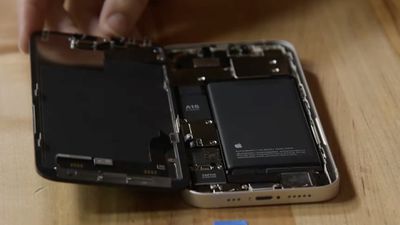Samsung Battery Technology Adapted From EVs Could Boost iPhone Battery Life
Samsung is planning to use a battery production technique normally used for electric vehicles to create more energy-dense smartphone batteries, in a move that could improve the battery life of future iPhone models, The Elec reports.
 Image via iFixit
Image via iFixitSamsung SDI, Samsung's battery and energy division, intends to use a production technique it currently uses to make fifth-generation batteries for electric vehicles (EVs) to manufacture batteries for tablets and smartphones, according to sources speaking to
The Elec. Rather than the wound jellyroll method that is often used to make rechargeable batteries, the EV method stacks battery materials in layers to increase energy density by over 10 percent without taking up any more internal space.
The company is said to be modifying production lines in South Korea to be able to manufacture the new batteries, and it has already built a pilot line for the stacking method in China. The Elec proposes that Samsung could be seeking to win orders from Apple for the new type of battery. Samsung SDI has supplied batteries for MacBook and iPad models in the past, but has never manufactured batteries for iPhones. Currently, Apple's main battery supplier is China's Amperex Technology.
Apple currently uses an L-shaped multi-cell battery in the iPhone, where multiple batteries are connected to make the best use of internal space and increase battery life. Batteries with higher energy density could allow Apple to move away from the multi-cell design, free up internal space, and make the iPhone lighter without sacrificing battery life, or retain the same design and moderately increase battery life.
Popular Stories
Apple is preparing a "bold" new iPhone Pro model for the iPhone's 20th anniversary in 2027, according to Bloomberg's Mark Gurman. As part of what's being described as a "major shake-up," Apple is said to be developing a design that makes more extensive use of glass – and this could point directly to the display itself.
Here's the case for Apple releasing a truly all-screen iPhone with no...
While the iPhone 17 Pro and iPhone 17 Pro Max are not expected to launch until September, there are already plenty of rumors about the devices.
Subscribe to the MacRumors YouTube channel for more videos.
Below, we recap key changes rumored for the iPhone 17 Pro models as of April 2025:
Aluminum frame: iPhone 17 Pro models are rumored to have an aluminum frame, whereas the iPhone 15 Pro and ...
If you have been experiencing issues with wireless CarPlay in your vehicle lately, it was likely due to a software bug that has now been fixed.
Apple released iOS 18.4.1 today, and the update's release notes say it "addresses a rare issue that prevents wireless CarPlay connection in certain vehicles."
If wireless CarPlay was acting up for you, updating your iPhone to iOS 18.4.1 should...
The first iOS 19 beta is less than two months away, and there are already a handful of new features that are expected with the update.
Apple should release the first iOS 19 beta to developers immediately following the WWDC 2025 keynote, which is scheduled for Monday, June 9. Following beta testing, the update should be released to the general public in September.
Below, we recap the key...
Apple's iPhone development roadmap runs several years into the future and the company is continually working with suppliers on several successive iPhone models simultaneously, which is why we often get rumored features months ahead of launch. The iPhone 17 series is no different, and we already have a good idea of what to expect from Apple's 2025 smartphone lineup.
If you skipped the iPhone...
Despite being more than two years old, Apple's AirPods Pro 2 still dominate the premium wireless‑earbud space, thanks to a potent mix of top‑tier audio, class‑leading noise cancellation, and Apple's habit of delivering major new features through software updates. With AirPods Pro 3 widely expected to arrive in 2025, prospective buyers now face a familiar dilemma: snap up the proven...
Apple may have updated several iPads and Macs late last year and early this year, but there are still multiple new devices that we're looking forward to seeing in 2025. Most will come in September or October, but there could be a few surprises before then.
We've rounded up a list of everything that we're still waiting to see from Apple in 2025.
iPhone 17, 17 Air, and 17 Pro - We get...
Apple today released iOS 18.4.1 and iPadOS 18.4.1, minor updates to the iOS 18 and iPadOS 18 operating systems that came out last September. iOS 18.4.1 and iPadOS 18.4.1 come two weeks after the launch of iOS 18.4 and iPadOS 18.4.
The new software can be downloaded on eligible iPhones and iPads over-the-air by going to Settings > General > Software Update.
There have been complaints about ...
Apple today updated its vintage products list to add the 2018 Mac mini and the iPhone 6s, devices that will get more limited service and repairs now that they are considered vintage.
The iPhone 6s initially launched in 2015, but Apple kept it around as a low-cost device until 2018, which is why it is only now being added to the vintage list. The iPhone 6s had Apple's A9 chip, and it was...
 Image via iFixit
Image via iFixit























